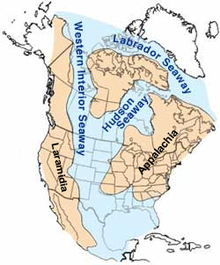Judith River Group

The Judith River Group (eng. Judith River Group ) is a sequence of sedimentary rocks of late Cretaceous ( Campanian ), which in the western North American open-minded is. This group is an important site for dinosaur fossils - among other things, Dinosaur Provincial Park in Alberta belongs to this rock unit , one of the richest sites for dinosaur fossils worldwide. The Judith River Group is sometimes in Alberta Belly River Group (eng. Belly River Group ) called, often it is also called Judith River Wedge called. The name is derived from the Judith River , a river in Montana. The Judith River Group is divided into three to four geological formations - the Foremost Formation, the Oldman Formation and the Dinosaur Park Formation ( Eng.Dinosaur Park Formation) in Alberta and Saskatchewan in Canada, as well as the Judith- River formation in central northern Montana . The Foremost is the lowest and oldest layer, while the Dinosaur Park Formation is the uppermost and youngest layer. The Judith River Formation in Montana corresponds to the Oldman Formation in Canada, both formations form the middle layer of the Judith River Group.
Geological history
Since the Middle Cretaceous, North America has been divided in half by an arm of the sea, the Western Interior Seaway . In the Campanium, the rise of the Rocky Mountains began through the Laramian mountain formation , which pushed the arm of the sea back to the east and south. The Judith River group settled on the west coast of the inlet; the deposits show a wide range of different ecosystems at different places and times due to fluctuating sea levels . There were marine habitats near the coast, near-coast marshland, deltas and lagoons, as well as the large flood plains from which most of the dinosaur fossils come. The flood plains were traversed by large rivers that flowed from the mountains into the estuarine - these rivers brought with them the sediments that make up the Two Medicine Formation in addition to the Judith River Group . The flood plains provided space for a rich flora and fauna - periodic droughts, however, repeatedly led to mass deaths, as can be seen from many bonebeds in the Judith River Formation and also in the Two Medicine Formation. Periodic volcanic eruptions in the west covered the region with ashes and led to further mass extinctions, but enriched the soil with nutrients for future plant growth. These ashes also allow researchers a precise radiometric dating of the rock layers. However, 73 million years ago the sea expanded again to the west and north, and the entire region was covered by the Bearpaw Sea, whose marine deposits now form the Bearpaw Formation in western North America.
Fossil finds
The Judith River Group is home to a wide variety of vertebrate fossils. Among other things, the remains of fish such as sharks , rays , sturgeons , bonefish and others have been preserved, as well as aquatic amphibians and reptiles , including frogs, salamanders, turtles, champsosaurus and crocodiles . Terrestrial lizards such as rail lizards , skinks , iguanas, and sneaks have also been spotted. Pterosaurs (Pterosauria) from the family of azhdarchidae and neornithe birds like Apatornis dominated the sky. In addition, there were enantiomeric birds such as Avisaurus and 20 species of mammals from the groups of multituberculates , marsupials and higher mammals .
So far, more than 40 different dinosaur species have been discovered, most of them from the Dinosaur Park Formation of the Dinosaur Provincial Park. Known genera among theropods include unspecified classifiable Coelurosaurier Paronychodon and Ricardoestesia that Ornithomimosaurier Dromiceiomimus , Ornithomimus and Struthiomimus that Caenagnathiden chirostenotes , elmisaurus and Caenagnathus , troodontids and Dromeosauriden as Troodon , saurornitholestes and Dromaeosaurus , indefinable Avimimiden - and Therizinosauroideen -Funde and Tyrannosaurids Gorgosaurus and Daspletosaurus with one. The ornithischia ( Ornithischia ) are also represented abundantly: Known are Ankylosauriden as Euoplocephalus and Nodosauriden as Edmontonia and Panoplosaurus , Pachycephalosaurier as gravitholus , Ornatotholus , Pachycephalosaurus , Stegoceras and hanssuesia , Ceratopsier as Leptoceratops , Anchiceratops , Centrosaurus , Chasmosaurus , Styracosaurus and Monoclonius and Hadrosauriden as Brachylophosaurus , Gryposaurus , Prosaurolophus , Corythosaurus , Lambeosaurus and Parasaurolophus .
Individual evidence
- ^ Raymond R. Rogers: Taphonomy of three dinosaur bonebeds in the Upper Cretaceous Two Medicine Formation of northwestern Montana: evidence for drought-induced mortality . In: Palaios . tape 5 , no. 5 , 1990, pp. 394-413 , doi : 10.2307 / 3514834 .
- ↑ Joseph M. English, Stephen T. Johnston: The Laramide Orogeny: what were the driving forces? In: International Geology Review . tape 46 , no. 9 , 2004, p. 833-838 , doi : 10.2747 / 0020-6814.46.9.833 .
- ↑ a b David A. Eberth: Encyclopedia of Dinosaurs . Ed .: Philip J. Currie, Kevin Padian. Academic Press, San Diego 1997, ISBN 0-12-226810-5 , Judith River Wedge, pp. 199-204 .
- ↑ P. Currie, B. Koppelhus (Eds.): Dinosaur Provincial Park: A Spectacular Ancient Ecosystem Revealed. Indiana University Press, Bloomington and Indianapolis 2005, p. 648.
- ↑ J. Ryan, C. Evans: Ornithischian dinosaurs. In: P. Currie, B. Koppelhus (Eds.): Dinosaur Provincial Park: A Spectacular Ancient Ecosystem Revealed. Indiana University Press, Bloomington and Indianapolis 2005, pp. 312-348.
